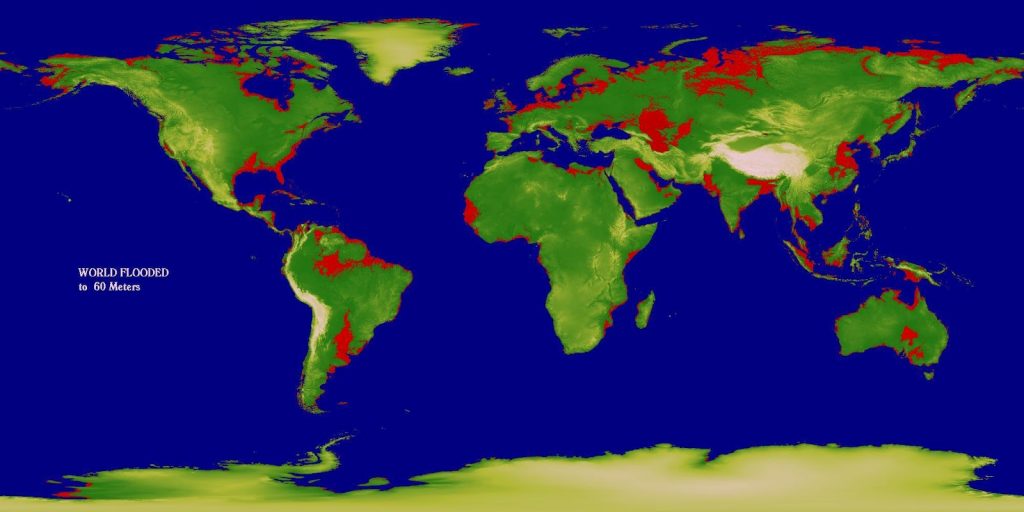Sea Level Rise: “Not My Problem”

“Rising sea level is a real problem for Florida” is something I hear often. It surprises people when I push back on that.
Of course, many low-lying parts of Florida are vulnerable to the rising waters. We all think immediately of Miami, but the Florida Keys, Fort Lauderdale, Tampa, and Jacksonville also have low elevation and are very susceptible to flooding from storm surge, heavy rainfall, and extreme tides. Those cities are all starting to assess and plan for rising seas, as the flooding gets worse by the decade – the remote effect as the great ice sheets on Greenland and Antarctica continue to melt faster and faster.
The reason I push back on those who label sea level rise and flooding as “a Florida problem”, is that the vulnerable areas are worldwide, affecting more places than most people realize. Narrowly focusing the area of vulnerability on Florida is misleading and undermines the awareness and action that is required by all coastal communities. It can be a method to avoid dealing with this unprecedented global threat.
Just to give an idea of the vulnerable areas if all the ice melted, the coarse map at the top shows in red, the areas that are less than 200 feet (60 meters) above sea level. Even a little bit of red – just a few pixels – may represent hundreds of square miles. To be clear, the full meltdown cannot happen this century and could take millennia. The map is not meant to be precise, but rather to show that coastal areas worldwide will be affected by sea level rise. Indeed, detailed vulnerability assessments are essential to determine the scope of exposure and the possible remedies in any coastal areas.
But just to get us thinking broadly, from Copenhagen to Calcutta and Seattle to Shanghai everyone needs to start considering the new reality as sea level rises foot by foot (meter by meter) to levels unknown for all human civilization. We are rather ignorant geologically. A little more than a hundred thousand years ago, the last high-water mark was some twenty feet (seven meters) above present. And that happened as part of a natural cycle, without the extra heat humans are now causing to be trapped in the Earth system.
Most people do not consider that:
- Even far up waterways, bays, marshlands, and tidal rivers shorelines can all be moved by rising seas.
- As a guideline, every foot of higher sea level can move shorelines three hundred feet inland, though that varies greatly depending on topography.
- Slowly rising sea level will increase the short-term floods from weather and extreme tides and eventually put most low-lying coastal land underwater.
- Even just a few inches of higher sea level will make a difference during sudden flood events, putting the water over a seawall, breaching a levee, or entering a building through the lowest door or window opening.
- Properties on high ground can be affected as utilities, transportation, fresh water supplies, and needed services in lower lying areas are interrupted. Even high elevation places far from the sea will have their global supply chains disrupted.
- The melting ice on Greenland and Antarctica will continue even with the most aggressive efforts to slow the warming – though that can slow things a bit.
If one wants to truly grasp the problem and the need for massive adaptation, simply take a moment and think of some low-lying coastal areas, starting with the ones nearest to you, and then expand globally using the graphic at the top as a guide. Just a few of the major cities that are particularly vulnerable:
- In the US: Seattle, San Francisco Bay Area, Sacramento, Houston, New Orleans, Mobile, Tampa, Miami/Fort Lauderdale, Jacksonville, Boston, Savannah, Charleston, Wilmington, Washington/Baltimore, Philadelphia, New York, Boston, Portland (ME).
- Internationally: Vancouver, London, Jakarta, Viet Nam, Bangladesh, Copenhagen, Calcutta, Mumbai, Shanghai, Beijing, Hong Kong, Tokyo, Manilla, Brazil, the Bahamas; the list could include hundreds more cities, thousands if we included smaller communities. (I know I have mixed some nations with cities.)
Rising sea level is a real problem in all of those places. Focusing on Florida tends to distract us from that reality. And with the global economy it is our problem, no matter where we live.
The sooner we firmly tag this in our collective consciousness, the sooner we will begin to really tackle sea level rise and the needed adaptation. The need to begin adaptation is the critical third “leg” to compliment efforts to be more sustainable, and more resilient. All three are now essential.
